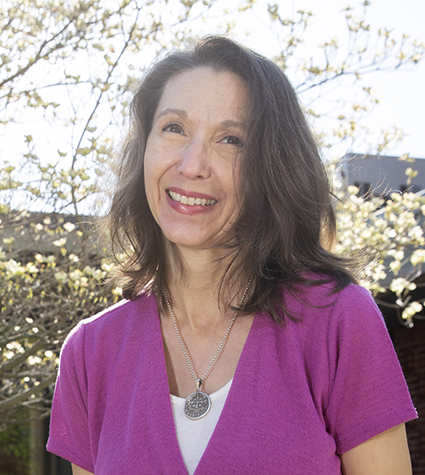 DentingerWhen Kristi Dentinger converted to Catholicism almost 30 years ago, it’s likely that she was given information on the Real Presence of Jesus Christ in the Eucharist, but she didn’t fully absorb what is the Church’s central teaching — that is, until a few years ago.
DentingerWhen Kristi Dentinger converted to Catholicism almost 30 years ago, it’s likely that she was given information on the Real Presence of Jesus Christ in the Eucharist, but she didn’t fully absorb what is the Church’s central teaching — that is, until a few years ago.
An active member of St. Peter Parish in Kirkwood, Dentinger attended an ACTS retreat with other women in the parish in early 2020, where she was chosen to give a talk on eucharistic adoration. Later during adoration at Mercy Retreat and Conference Center, Dentinger had what she describes as am “overwhelming” encounter with the Lord, where her eyes were opened to His Real Presence in the Eucharist.
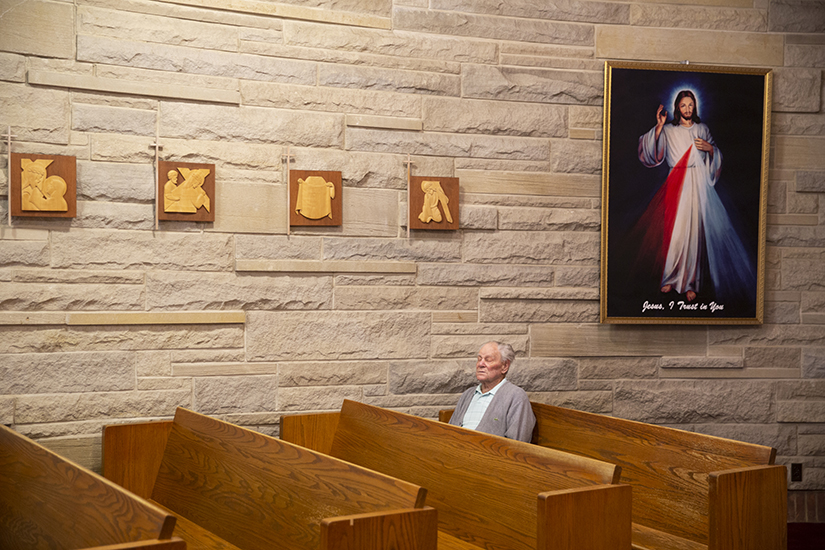 Ron McKinney, a parishioner at St. Ferdinand Parish in Florissant, prayed during eucharistic adoration March 24 at the St. Ferdinand Adoration Chapel.Photo Credit: Jacob Wiegand
Ron McKinney, a parishioner at St. Ferdinand Parish in Florissant, prayed during eucharistic adoration March 24 at the St. Ferdinand Adoration Chapel.Photo Credit: Jacob WiegandThe encounter was so profound that Dentinger has felt called to share with others the beauty and truth of the Real Presence in the Eucharist. In 2021, she began the Real Presence Foundation to spread the word about the Real Presence to Catholics of all ages. She has given presentations to schoolchildren and adults at St. Peter and hopes to bring the program to other parishes and schools in the archdiocese.
Dentinger, who coordinates the Eucharistic Adoration Committee at St. Peter and has expanded adoration times at the parish, knows that it can be difficult to understand the mystery of Jesus’ Real Presence in the Eucharist, which is understood as the Body, Blood, soul and divinity of our Lord, truly present under the appearances of bread and wine, and transformed through the prayers of the priest.
A 2019 Pew Research Center study revealed that 69% of all self-identified U.S. Catholics said they believed the bread and wine used at Mass are not Jesus, but instead are “symbols of the Body and Blood of Jesus Christ.” Only 31% said they believed in the Real Presence of Jesus in the Eucharist.
Though the study has been criticized by several Catholic scholars, it got the attention of the U.S. bishops, who are launching a three-year Eucharistic Revival in June to help address what they see as a catechetical crisis and address one of the reasons why people leave the Church. (See related.)
Dentinger sees her awakening to the Real Presence as something that happened in God’s time. “I don’t know if my eyes and ears were shut to this until now, but when you’re ready, your teacher shows up in His timing, and He has taught me,” she said. “I wish I knew this earlier, but that’s what I want to teach to others. I want for Him to change and transform their lives as He has changed and transformed mine.”
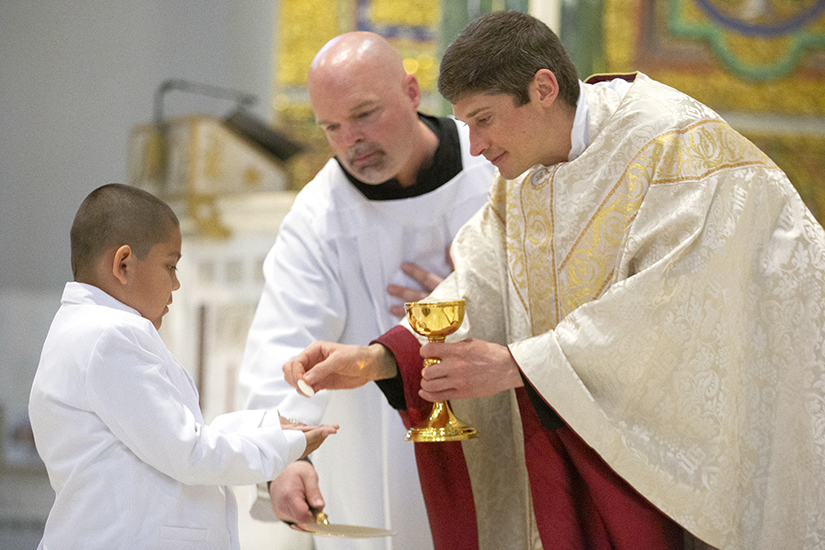 Luis Garcia, a second-grader at St. Cecilia School & Academy, received his first Communion from Father Tim Noelker on April 23 at St. Cecilia Church in St. Louis. At center is acolyte Patrick Ebert.Photo Credit: Jacob Wiegand
Luis Garcia, a second-grader at St. Cecilia School & Academy, received his first Communion from Father Tim Noelker on April 23 at St. Cecilia Church in St. Louis. At center is acolyte Patrick Ebert.Photo Credit: Jacob WiegandOn the Eucharist
The Church describes the Eucharist as the “source and summit” of our Catholic faith. The Catechism of the Catholic Church explains that “the Holy Eucharist completes Christian initiation. The Eucharist is the heart and the summit of the Church’s life, for in it Christ associates His Church and all Her members with His sacrifice of praise and thanksgiving offered once for all on the cross to his Father; by this sacrifice He pours out the graces of salvation on His Body which is the Church.” (CCC 1322, 1407)
Pope Francis has described Communion as the “sacrament of love.”
“Together with baptism and confirmation, it constitutes the source of the Church’s life itself,” the pope said. “From this sacrament of love, in fact, flows every authentic journey of faith, of communion, and of witness.”
Our understanding of the Real Presence of Jesus in the Eucharist traces back to the early Church. There are numerous references in Scripture, including when Jesus told His disciples: “I am the living bread which came down from heaven … if anyone eats this bread, he will live forever … I say to you, unless you eat the flesh of the Son of man and drink His blood, you have no life in you; he who eats my flesh and drinks my blood abides in me, and I in him. …” (John 6:25-58).
We can also find references in all four Gospels about Jesus’ institution of the Eucharist at the Last Supper. (Matthew 26:17-30; Mark 14:12-26; Luke 22:7-39; John 13:1-17:6).
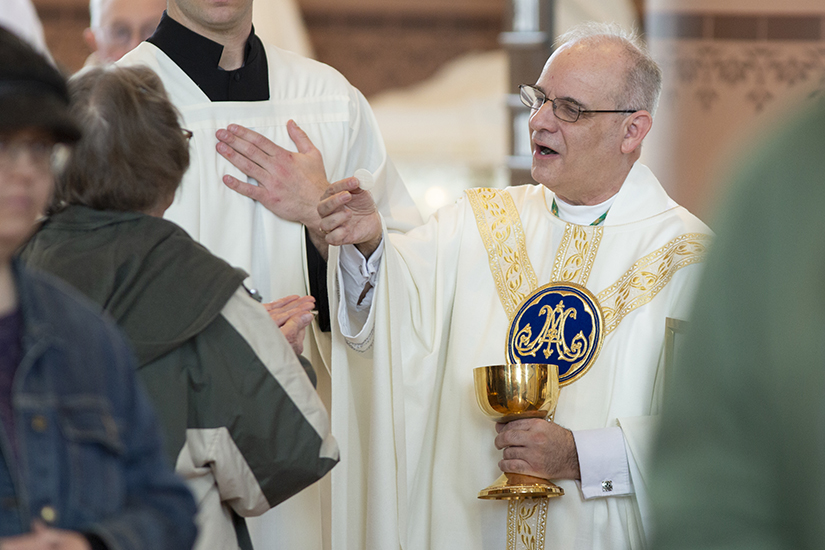 Bishop Mark Rivituso distributed the Eucharist during Communion on March 25 at the Basilica of
St. Louis, King of France (Old Cathedral) in St. Louis.Photo Credit: Jacob Wiegand
Bishop Mark Rivituso distributed the Eucharist during Communion on March 25 at the Basilica of
St. Louis, King of France (Old Cathedral) in St. Louis.Photo Credit: Jacob WiegandThe mystery of the Real Presence in the Eucharist
The Real Presence of Jesus in the Eucharist is indeed a mystery. It is difficult for humans to understand this mystery, but we do our best to understand through definitions given to us by the Church, such as transubstantiation — which means to change from one substance to another.
When the priest consecrates the bread and wine, we believe there is a miraculous transformation into the Body and Blood of Jesus. In this case, the substance changes, but the accidents (secondary characteristics or the changeable aspects of a thing) stay the same.
There are many eucharistic miracles that help reinforce our belief in the Real Presence in the Eucharist, which Dentinger has incorporated into her presentations. She also shares the story of Blessed Carlos Acutis, an Italian teenager who, before his death from leukemia in 2006, put his computer knowledge to use by creating an online database of eucharistic miracles around the world.
One example that Dentinger shares is of a Communion host that had fallen from a priest’s hands at a church in Sokółka, Poland, in 2008 and was later found to have a red substance on it. Scientists tested the host and discovered that it was a piece of heart muscle, which had shown signs of great trauma.
Other examples of reported eucharistic miracles are in Lanciano, Italy, in 750; a Mass celebrated by Pope St. Gregory the Great in Rome in 595; and in Turin, Italy, on the feast of Corpus Christi in 1453.
Dentinger said that God has impressed upon her that, “He desires to be known as the King of Love, and this is a sacrament of His love.
“When we go before Him in adoration, He just wants us to come and love Him,” she said. “He doesn’t want anything else but for us to give Him our heart.”
The more we take in Jesus in the Eucharist, the more we become like Him, Dentinger said. “The Lord is here with us on earth preparing our place in heaven that He desires to share with us.”
What is the Eucharist?
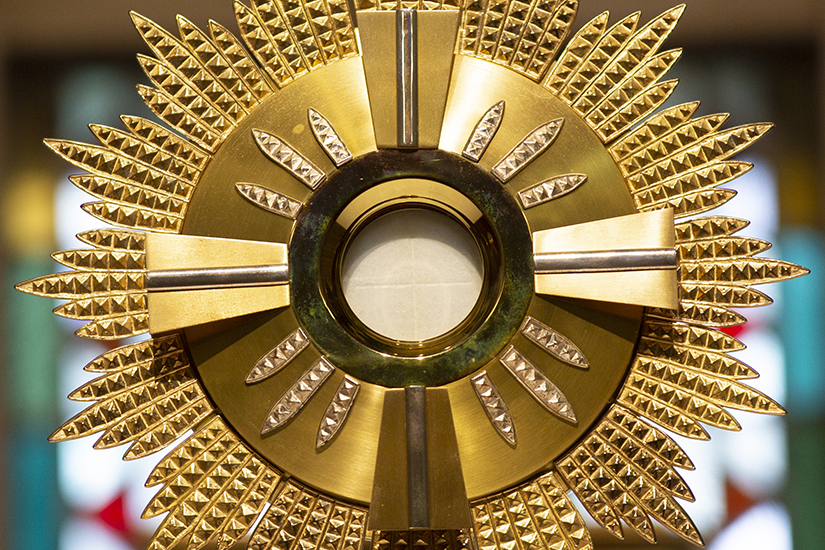 A monstrance containing the Eucharist sat on an altar March 24 at the St. Ferdinand Adoration Chapel in Florissant. Photo Credit: Jacob Wiegand
A monstrance containing the Eucharist sat on an altar March 24 at the St. Ferdinand Adoration Chapel in Florissant. Photo Credit: Jacob WiegandThe term transubstantiation is used when bread and wine become the Body and Blood of Jesus. They do not become symbols of the Body and Blood; they become the actual Body and Blood of Jesus.
Different types of changes occur, even though our senses have not seen any change. For example, if a piece of paper is torn, it has changed. It’s still paper, but the appearance has changed. Some changes occur that can’t be seen. For example, when you learn something new, a change has occurred inside you, but it can’t be seen on the outside. You remain the same person as before.
When bread and wine are changed into the Body and Blood of Christ, they change completely; their substance changes and they become Jesus, truly present. However, the appearances do not change; they still appear as bread and wine.
God has given us eucharistic miracles as examples of teaching us about the Real Presence of Jesus in the Eucharist.
Eucharistic Revival
The Archdiocese of St. Louis will launch a Eucharistic Revival on Sunday, June 19.
The U.S. bishops are calling for a three-year grassroots revival of devotion and belief in the Real Presence of Jesus in the Eucharist. They believe that God wants to see a movement of Catholics across the United States, healed, converted, formed and unified by an encounter with Jesus in the Eucharist — and sent out in mission “for the life of the world.”
All parishes in the archdiocese will be invited to ring their bells in unity at 3 p.m. on June 19, following a Holy Hour the week of June 13 to prepare for the revival.
The mission of the national revival effort is to renew the Church by enkindling a living relationship with the Lord Jesus Christ in the Eucharist. The four main pillars of the movement are healing, conversion, formation and unity.
For more information on the national Eucharistic Revival, visit eucharisticrevival.org. For information on the Eucharistic Revival in the Archdiocese of St. Louis, see allthingsnew.archstl.org/eucharistic-revival.